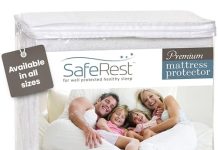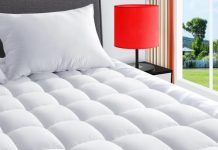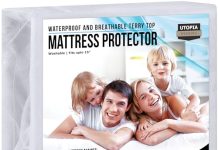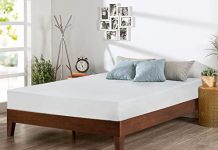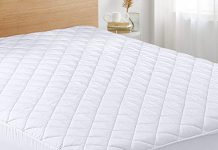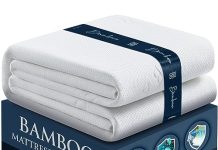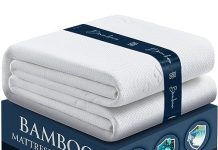
In our article, we will share some valuable tips and tricks on how to protect your precious mattress from spills, accidents, and damage. We all know how frustrating it can be when a perfectly good mattress gets stained or ruined, but worry no more! With a few simple steps and some preventive measures, you can extend the lifespan of your mattress and keep it looking and feeling as good as new. So, let’s dive in and discover how you can safeguard your mattress from all sorts of mishaps and mishaps.
Review contents
Waterproof Mattress Protectors
Choosing the Right Waterproof Mattress Protector
When it comes to protecting your mattress, investing in a waterproof mattress protector is a wise choice. These protectors create a barrier between your mattress and any spills, accidents, or damage that may occur. However, with so many options available, it can be overwhelming to choose the right one for your needs.
When selecting a waterproof mattress protector, consider the size and depth of your mattress, as well as the material of the protector. Ensure that the protector is compatible with your mattress size to guarantee a snug fit. Additionally, choose a material that is not only waterproof but also breathable, to prevent trapping moisture and allowing for air circulation.
Installation and Maintenance Tips
Installing a waterproof mattress protector is a simple process that can be done by anyone. Start by removing all bedding from your mattress and unpackage the protector. Place the protector over the mattress, making sure it fits snugly and covers the entire surface. Secure it in place with the elasticized corners or zipper closure, if applicable.
To ensure the longevity and effectiveness of your waterproof mattress protector, it’s important to properly maintain it. Follow the manufacturer’s instructions for cleaning and care. Generally, most waterproof mattress protectors can be machine washed and tumble dried on low heat. Regularly washing and drying the protector will help to remove any bacteria or allergens, keeping your sleep environment clean and healthy.
Benefits of Using a Waterproof Mattress Protector
Using a waterproof mattress protector offers several benefits that go beyond just protecting your mattress from spills and accidents. Firstly, it creates a hygienic barrier between you and your mattress, preventing the build-up of dust mites, allergens, and bacteria. This is particularly beneficial for individuals with allergies or asthma, as it reduces the risk of triggering symptoms.
Additionally, a waterproof mattress protector helps to extend the lifespan of your mattress. By preventing stains, spills, and body fluids from reaching the mattress, it avoids the need for deep cleaning, potentially saving you time and money in the long run. It also helps to maintain the integrity of the mattress, ensuring its proper support and comfort for years to come.
Stain Removal Techniques
Dealing with Common Stains
Accidents happen, and when they do, it’s important to know how to effectively remove stains from your mattress. Different stains require different cleaning methods, so here are a few common stains and how to tackle them:
- Urine Stains: Start by blotting up any excess urine using paper towels or a clean cloth. Mix equal parts vinegar and water, and gently blot the stain with the solution using a clean cloth. Afterward, sprinkle baking soda over the area and let it sit for a few hours to absorb any remaining odor. Finally, vacuum up the baking soda.
- Blood Stains: Immediately rinse the stain with cold water to dilute the blood. Make a paste using hydrogen peroxide and a small amount of liquid dish soap. Apply the paste to the stain and let it sit for a few minutes before gently scrubbing with a clean cloth or sponge. Rinse with cold water and blot dry.
- Food and Drink Stains: Start by removing any solid particles with a spoon or dull knife. Mix a small amount of mild detergent with warm water and gently blot the stain with the solution using a clean cloth. Avoid saturating the mattress, as it can promote mold and mildew growth. Blot with a dry cloth to absorb excess moisture.
Using Household Products for Stain Removal
In addition to specific stain removal techniques, there are a few common household products that can be effective in removing stains from your mattress:
- Baking Soda: Sprinkling baking soda over a stain can help to absorb moisture and eliminate odor. Let it sit for a few hours or overnight, then vacuum it up.
- Lemon Juice: Lemon juice is a natural bleach and can be effective in removing stains. Dilute it with water and blot the stain using a clean cloth soaked in the mixture. Rinse with water and blot dry.
- White Vinegar: White vinegar is a versatile cleaning agent that can be used to remove various stains. Mix equal parts white vinegar and water, and gently blot the stain with the solution using a clean cloth. Rinse with water and blot dry.
Preventing Stains from Setting In
While knowing how to remove stains is important, it’s even better to prevent them from setting in the first place. Here are some tips to help prevent stains on your mattress:
- Use a Waterproof Mattress Protector: Investing in a waterproof mattress protector is the best defense against stains. It creates a barrier between your mattress and any spills or accidents, ensuring that your mattress remains clean and stain-free.
- Act Quickly: If a spill or accident does occur, it’s essential to act quickly. The longer a stain sits, the more difficult it becomes to remove. Blot up any excess liquid immediately and follow the appropriate stain removal techniques as soon as possible.
- Avoid Eating or Drinking in Bed: While it may be tempting to have a snack or beverage in bed, it increases the risk of spills and stains. Try to keep food and drinks confined to other areas of your home, away from your mattress.
Mattress Cleaning Methods
Regular Vacuuming
Regular vacuuming is essential for maintaining a clean and healthy sleep environment. It helps to remove dust, allergens, and debris that can accumulate on the surface of your mattress over time. To effectively vacuum your mattress, follow these steps:
- Remove Bedding: Start by removing all bedding from your mattress, including sheets, pillowcases, and mattress protectors.
- Pre-Treat Stains: Before vacuuming, pre-treat any visible stains using the appropriate stain removal techniques mentioned earlier. Allow the stain to dry completely before moving on to the next step.
- Vacuum the Surface: Attach the upholstery attachment to your vacuum cleaner and thoroughly vacuum the entire surface of the mattress. Pay special attention to the seams, corners, and edges, where dust and debris tend to accumulate.
- Clean the Upholstery Attachment: After vacuuming, it’s important to clean the upholstery attachment to prevent the transfer of dirt and allergens to other surfaces. Check the manufacturer’s instructions for cleaning and maintenance of your vacuum cleaner.
Deep Cleaning Techniques
While regular vacuuming is sufficient for general maintenance, deep cleaning your mattress periodically can help remove deep-seated dirt, odors, and stains. Here are a few deep cleaning techniques to consider:
- Steam Cleaning: Steam cleaning is an effective method for deep cleaning mattresses. It uses high-temperature steam to kill dust mites, allergens, and bacteria, while also removing dirt and stains. Follow the manufacturer’s instructions for your steam cleaner and ensure that your mattress is properly dried afterward to prevent mold and mildew growth.
- Baking Soda Treatment: Baking soda is a natural deodorizer and can help to remove odors from your mattress. Sprinkle a generous amount of baking soda over the entire surface of the mattress and let it sit for several hours or overnight. Vacuum up the baking soda using the upholstery attachment on your vacuum cleaner.
Using Natural Cleaning Solutions
If you prefer to use natural cleaning solutions, there are several options that can effectively clean and freshen your mattress:
- Vinegar and Water: Mix equal parts white vinegar and water in a spray bottle. Lightly spray the solution over the surface of the mattress, being careful not to saturate it. Allow it to air dry or use a fan to speed up the drying process.
- Hydrogen Peroxide: Hydrogen peroxide is a powerful cleaning agent that can be effective in removing stains and odors. Mix equal parts hydrogen peroxide and water in a spray bottle. Lightly mist the solution over any stained areas and allow it to sit for a few minutes. Blot the area with a clean cloth to remove excess moisture.
Protective Bedding Accessories
Mattress Toppers for Added Protection
If you’re looking for an extra layer of protection for your mattress, consider investing in a mattress topper. Not only do mattress toppers provide additional cushioning and comfort, but they also act as a protective barrier between you and your mattress. Look for a mattress topper that is waterproof and hypoallergenic, to ensure maximum protection and comfort.
Choosing the Right Pillow Protectors
Pillows are just as vulnerable to spills and accidents as mattresses, so it’s important to invest in pillow protectors to keep them clean and fresh. When selecting pillow protectors, consider the material and ensure that they are waterproof, breathable, and machine washable. Pillow protectors prolong the lifespan of your pillows, eliminate allergens, and provide a hygienic sleep environment.
Using Mattress Encasements to Prevent Allergens
For individuals who suffer from allergies or asthma, mattress encasements can be a game-changer. These encasements completely surround the mattress, creating a barrier against dust mites, bed bugs, and allergens. Look for encasements that are breathable, waterproof, and allergen-proof. They not only protect your mattress but also provide relief from allergy symptoms, allowing you to enjoy a restful night’s sleep.
Avoiding Damage from Pets
Training Your Pets to Stay Off the Bed
If you have furry friends who like to snuggle up on the bed, it’s essential to train them to stay off to prevent damage to your mattress. Here’s how you can train your pets:
- Establish Boundaries: Set clear boundaries for your pets by using verbal commands, positive reinforcement, and rewards. Train them to stay off the bed and provide them with their own comfortable sleeping area.
- Provide Alternatives: Create a cozy and inviting space for your pets away from the bed. Use pet beds or blankets to designate their sleeping area and make it as comfortable as possible.
- Consistency is Key: Be consistent with your training and reinforce the boundaries regularly. Consistent reinforcement will help your pets understand that the bed is off-limits and that they have their own special place.
Using Pet-Friendly Bedding Solutions
Sometimes even the best-trained pets can have accidents or leave behind fur and dander. To protect your mattress from pet-related damage, consider using pet-friendly bedding solutions:
- Waterproof Mattress Protector: Invest in a waterproof mattress protector that is specifically designed for pet owners. These protectors have an extra layer of protection to safeguard against accidents and spills.
- Pet-Friendly Sheets and Blankets: Opt for sheets and blankets that are easy to clean and resistant to pet hair and odors. Choose materials that are durable and can withstand regular washing and drying.
Addressing Urine Accidents Effectively
Despite our best efforts, urine accidents can happen with pets. When accidents occur, it’s important to address them promptly to prevent stains and odors. Here’s how to effectively clean up urine accidents:
- Blot the Area: Start by blotting up as much of the urine as possible using paper towels or a clean cloth. Avoid rubbing or scrubbing, as it can spread the urine and make the stain worse.
- Use Enzymatic Cleaners: Enzymatic cleaners are specifically formulated to break down urine stains and eliminate odors. Follow the instructions on the cleaner and apply it to the stained area. Allow it to sit for the recommended time before blotting the area again.
- Air Dry and Deodorize: After cleaning the urine stain, allow the area to air dry completely. Once dry, sprinkle baking soda over the area to absorb any remaining odor. Let it sit for a few hours before vacuuming up the baking soda.
Preventing Spills and Accidents
Avoiding Food and Beverages on the Bed
One of the easiest ways to prevent spills and accidents on your mattress is to avoid eating and drinking in bed. While it may be tempting to enjoy a late-night snack or a morning cup of coffee in the comfort of your bed, it increases the risk of spills and stains. Keep food and beverages confined to the kitchen or dining area to minimize the chances of accidents.
Using Bedside Tables or Trays
If you often find yourself needing to have a drink or snack near your bed, invest in a bedside table or tray. These provide a stable surface for placing your items, reducing the risk of spills and stains on your mattress. Choose a table or tray that is large enough to accommodate your needs and easily accessible from your bed.
Watching Out for Young Children
Young children are prone to accidents and spills, so it’s important to take extra precautions to protect your mattress. Here are some tips to keep in mind when dealing with young children:
- Use Waterproof Mattress Protectors: Invest in waterproof mattress protectors specifically designed for children. These protectors provide an extra layer of defense against accidents and spills.
- Set Clear Rules: Establish rules with your children regarding food and beverages in bed. Teach them the importance of using tables or trays to prevent spills and stains.
- Create a Child-Friendly Sleeping Area: If your child is transitioning to a big kid bed, consider creating a child-friendly sleeping area. Use washable bedding, soft pillows, and protective barriers to minimize the risk of accidents and damage to the mattress.
Managing Bedwetting Issues
Understanding Bedwetting Causes
Bedwetting, also known as nocturnal enuresis, is a common issue that can affect children and even some adults. Understanding the causes of bedwetting can help in managing and preventing future incidents. Some common causes include:
- Developmental Delays: Children who experience developmental delays may take longer to gain control over their bladder during sleep.
- Genetics: Bedwetting can sometimes run in families, suggesting a genetic component.
- Emotional Stress: Stressful events, such as moving to a new home or starting school, can trigger bedwetting in some individuals.
Bedwetting Alarms and Remedies
Bedwetting alarms can be an effective tool in managing and eventually overcoming bedwetting. These alarms work by detecting moisture and prompting the individual to wake up and use the bathroom. Over time, the individual learns to wake up on their own before a bedwetting incident occurs. In addition to alarms, there are several other remedies that can help in managing bedwetting:
- Limit Fluid Intake: Limiting fluids, especially close to bedtime, can help reduce the likelihood of bedwetting incidents.
- Bedtime Toileting: Encourage regular toileting before bed to empty the bladder as much as possible.
- Positive Reinforcement: Offer praise and rewards for dry nights to motivate and reinforce the desired behavior.
Seeking Medical Advice for Chronic Bedwetting
While occasional bedwetting is typically a normal part of a child’s development, chronic bedwetting may require medical attention. If bedwetting persists beyond the age of 6 or is causing significant distress, it’s recommended to seek advice from a healthcare professional. They can help identify any underlying medical conditions and suggest appropriate treatment options.
Maintaining a Healthy Sleep Environment
Ventilating the Mattress Regularly
Proper ventilation is essential for maintaining a healthy sleep environment. Regularly ventilating your mattress helps to reduce the buildup of moisture, mold, and mildew. Here are a few ways to ventilate your mattress:
- Remove Bedding: Start by removing all bedding, including sheets, pillowcases, and mattress protectors.
- Open Windows: If weather permits, open the windows in your bedroom to allow fresh air to circulate. This helps to dry out any moisture trapped within the mattress.
- Use a Fan: If opening the windows is not an option, use a fan to create airflow in your bedroom. Direct the fan towards the mattress to aid in drying and ventilation.
Rotating and Flipping the Mattress
To ensure even wear and maximize the lifespan of your mattress, it’s important to rotate and flip it regularly. Here’s how to properly rotate and flip your mattress:
- Rotate: Start by rotating the mattress 180 degrees, so the foot of the mattress is now at the head. This helps to distribute body weight and prevent sagging in specific areas.
- Flip: If your mattress is double-sided, flip it over entirely. This ensures that both sides of the mattress receive equal wear and support.
- Follow Manufacturer’s Guidelines: Always refer to the manufacturer’s guidelines regarding rotating and flipping your specific mattress. Some mattresses are designed to be one-sided and should not be flipped.
Using Mattress Protectors for Allergies
If you suffer from allergies, investing in mattress protectors specifically designed for allergies is crucial. These protectors create a barrier between you and any allergens that may be present in your mattress, such as dust mites, pet dander, and pollen. Look for protectors that are hypoallergenic, breathable, and easy to clean. These protectors can help alleviate allergy symptoms and ensure a restful night’s sleep.
Repairing Minor Damage
Handling Small Tears or Holes
Minor damage to your mattress, such as small tears or holes, can be repaired at home with a few simple steps:
- Clean and Dry the Area: Start by cleaning the damaged area with a mild detergent and warm water. Allow it to dry completely before proceeding.
- Apply a Patch: Cut a patch from a sturdy fabric, slightly larger than the damaged area. Apply a thin layer of fabric adhesive to the edges of the patch and press it onto the damaged area, ensuring a secure bond.
- Let it Cure: Follow the manufacturer’s instructions and allow the adhesive to cure for the recommended time. Avoid using the mattress until the adhesive is fully set and cured.
Fixing Loose or Broken Springs
If you notice loose or broken springs in your mattress, it’s best to seek professional assistance or consider replacing the mattress altogether. Attempting to fix springs at home without the necessary tools and expertise can potentially cause further damage and compromise the integrity of the mattress.
Dealing with Slight Frays or Snags
Slight frays or snags on the fabric of your mattress can be addressed with some simple steps:
- Trim Loose Threads: Using a pair of sharp scissors, carefully trim any loose threads or frayed areas. Be cautious not to cut into the fabric of the mattress.
- Secure Snags: If you notice a snag in the fabric, gently stretch the surrounding area to smooth it out. Use a small needle and thread to carefully secure the loose thread, stitching it back into place.
Remember, it’s important to handle minor repairs with caution and if you have any doubts or concerns, it’s always best to consult a professional.
Professional Mattress Cleaning Services
Benefits of Hiring Professional Cleaners
While regular maintenance and cleaning are crucial for the longevity and hygiene of your mattress, there are times when professional cleaning services are necessary. Here are some benefits of hiring professional cleaners:
- Expertise and Equipment: Professional cleaners have the expertise and specialized equipment to effectively clean and sanitize your mattress. They can tackle tough stains, remove deep-seated dirt and allergens, and restore your mattress to its original condition.
- Time and Convenience: Cleaning a mattress thoroughly can be time-consuming and labor-intensive. Hiring professionals saves you the time and effort, allowing you to focus on other tasks or enjoy your free time.
- Deep Cleaning and Sanitization: Professional cleaning services go beyond surface cleaning. They use techniques and products that penetrate deep into the mattress, eliminating bacteria, dust mites, and allergens that may be lurking within.
Choosing a Reputable Cleaning Company
When choosing a professional cleaning company for your mattress, it’s important to do thorough research to ensure you are hiring a reputable and reliable service. Here are a few factors to consider:
- Reviews and Recommendations: Read reviews and seek recommendations from friends, family, or online sources. Look for companies with a history of satisfied customers and positive feedback.
- Certifications and Training: Check if the cleaning company has any certifications or training in mattress cleaning. This ensures that they have the necessary knowledge and skills to perform the job effectively and safely.
- Insurance and Guarantee: Inquire about the company’s insurance policy and guarantee. A reputable cleaning company should have liability insurance to cover any damages that may occur during the cleaning process. They should also offer a satisfaction guarantee, assuring you of a job well done.
Understanding the Cleaning Process
When hiring professional cleaners for your mattress, it’s helpful to understand the cleaning process they will follow. Here is a general overview of what to expect:
- Inspection: The cleaners will inspect your mattress for any existing damage or stains that may require special attention.
- Preparation: The mattress will be prepared for cleaning by removing all bedding and vacuuming any loose debris or dirt.
- Cleaning Solution Application: The cleaners will apply a suitable cleaning solution to the mattress, targeting stains and odors. They may use specialized equipment, such as steam cleaners or extraction machines, to deep clean and sanitize the mattress.
- Drying: Proper drying is crucial to prevent mold and mildew growth. The cleaners will ensure that the mattress is dried thoroughly before replacing any bedding.
- Final Inspection: Once the cleaning process is complete, the cleaners will conduct a final inspection to ensure that the mattress is clean, fresh, and ready for use.
Hiring professional cleaners can give you peace of mind, knowing that your mattress is in capable hands and will be thoroughly cleaned and sanitized.


